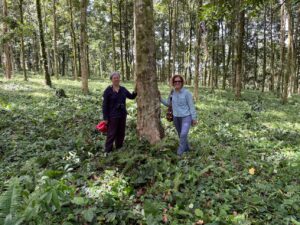A Griffith University-led project is working with Soloman Island communities to test different ways of restoring forests to benefit local residents and revitalise ecosystems.

Professor Helen Wallace.
The Livelihoods in Forest Ecosystem Recovery (LIFER) project is helmed by Griffith’s Centre for Planetary Health and Food Security Director Professor Helen Wallace for ACIAR, who said there was a critical need to find ways to restore the forests in Solomon Islands.
“This is an important part of Solomon Islands government policy because it is potential future revenue, but it is also important for the livelihoods of local communities,” Professor Wallace said.
“In addition to export income, about 90% of people in Solomon Islands are dependent on forests for all sorts of things, for food, for medicine, for animals that live there, for building materials.
“Between 80% and 90% of forests have been logged and people have lost access to that resource.”
Many of these repeatedly logged forests have failed to regenerate naturally and now the country is running out of timber for its own communities and for export.
LIFER is a six-year project that began in January 2023, building on a pilot project funded by the US Forest Service on Kolombangara Island.
The project is funded by an Australia Centre for International Agricultural Research grant valued at $3,544,265, which was awarded to Professor Wallace and the team in November 2022.
Four experimental restoration treatments are planned, which will then be replicated in up to eight communities:
- Treatment 1 will serve as the control, with protection but no active effort to restore the forest.
- Treatment 2 is ‘assisted natural regeneration’ where weeding and thinning, for instance, will be used to help valuable species re-establish themselves.
- Treatment 3 is ‘enrichment’ and includes management activities and replanting trees that communities have identified as important for future use.
- Treatment 4 is a more intensive ‘agroforestry’ approach, with substantial planting of timber species, along with other useful tree and food crops.
Professor Wallace said the first steps involved talking to communities about how they use their forests and what they want and need from future forests. 
“We have some species in mind for the different treatments, such as indigenous fruit trees and nut trees like Canarium indicum, which produces ngali nut (also known as the galip nut), along with species commonly used for building materials, and some target timber species,” she said.
“But final tree selection will be guided by the participating communities.”
The LIFER project will fund participating communities to maintain the trial sites during the life of the project and to help monitor tree growth, biodiversity and livelihood benefits.
The project will also explore other activities to support livelihoods, such as nurseries to produce seedlings, gathering herbs for food and medicine and beekeeping, which provide ways for women in particular to earn money.
“We really want to empower local women and give them a voice in forest management and promote leadership in forest governance. This will include working with the National Council of Women,” Professor Wallace said.






